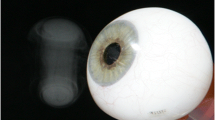Abstract
For the last several decades, the predominant method for delivering medicine to the surface of the eye has been the standard multiuse eye dropper. While being the most popular, this method has significant limitations. Recently, an effort has been made to explore the use of a directed toroidal vortex or “smoke ring” aerosol delivery system that may help overcome these limitations and enable delivery of precise amounts of formulation and drug to the ocular surface. Promising preliminary in vitro studies indicated dosing control, but the physical characteristics of the toriodal aerosol device performance and impaction forces related to patient comfort have yet to be established. Here, we experimentally investigate the mechanics and dynamics of these ocular aerosol vortices, including translational and rotational velocities, spatial droplet size distributions, and relative impaction forces in order to optimize the device performance and evaluate potential for clinical use. Maximal droplet velocity at various actuation forces was determined, and they were found to be all less than 6 m/s even at the highest actuation forces. Moreover, plume impaction forces were determined across a range of conditions and were all less than about 4.5 μN. Collectively, these studies showed that the physical and mechanical properties of the emitted drug-loaded vortices would be suitable for ocular administration.


















Similar content being viewed by others
References
Weinreb RN, Khaw PT. Primary open-angle glaucoma. Lancet. 2004;363(9422):1711–20.
Zhang K, Zhang L, Weinreb RN. Ophthalmic drug discovery: novel targets and mechanisms for retinal diseases and glaucoma. Nat Rev Drug Discov. 2012;11(7):541–59.
Rein DB, Zhang P, Wirth KE, Lee PP, Hoerger TJ, McCall N, et al. The economic burden of major adult visual disorders in the United States. Arch Ophthalmol. 2006;124(12):1754–60.
Urtti A. Challenges and obstacles of ocular pharmacokinetics and drug delivery. Adv Drug Deliv Rev. 2006;58(11):1131–5. https://doi.org/10.1016/j.addr.2006.07.027.
Molokhia SA, Thomas SC, Garff KJ, Mandell KJ, Wirostko BM. Anterior eye segment drug delivery systems: current treatments and future challenges. J Ocul Pharmacol Ther. 2013;29(2):92–105.
Collins JF, Dartt DA, Dana R. Mist delivery of eye medication to the anterior segment. Am J Ophthalmol. 2007;144(1):137–9.
Halberg GP, Kelly S, Morrone M. Drug delivery systems for topical ophthalmic medication. Ann Ophthalmol. 1975;7(9):1199–204. 207-9
Martini LG, Embleton JK, Malcolmson RJ, Wilson CG. The use of small volume ocular sprays to improve the bioavailability of topically applied ophthalmic drugs. Eur J Pharm Biopharm. 1997;44(2):121–6.
Kahn M. Bioavailability of vitamin B12 using a small-volume nebulizer ophthalmic drug delivery system. Clin Exp Ophthalmol. 2005;33(4):402–7.
Diestelhorst M, Hellmich M, Hochrainer D, Roessler G, Steinfeld A, Zierenberg B. The ocular bioavailability from a new microspray MO. A comparison with conventional eye drops. Invest Ophthalmol Vis Sci. 2006;47(13):457.
Chrai SS, Patton TF, Mehta A, Robinson JR. Lacrimal and instilled fluid dynamics in rabbit eyes. J Pharm Sci. 1973;62(7):1112–21.
Elibol O, Alcelik T, Yuksel N, Caglar Y. The influence of drop size of cyclopentolate, phenylephrine and tropicamide on pupil dilatation and systemic side effects in infants. Acta Ophthalmol Scand. 1997;75(2):178–80.
Coulter RA. Pediatric use of topical ophthalmic drugs. Optometry. 2004;75(7):419–29.
Wheatcroft S, Sharma A, McAllister J. Reduction in mydriatic drop size in premature infants. Br J Ophthalmol. 1993;77(6):364–5.
Patton T, Robinson J. Pediatric dosing considerations in ophthalmology. J Pediatr Ophthalmol. 1976;13(3):171–8.
Smyth HD, Herpin MJ, inventors; Board of Regents, The University of Texas System (Austin, TX, US), assignee. Toroidal pharmaceutical formulations. United States patent # 9,119,773. 2015.
Hochrainer D, Hölz H, Kreher C, Scaffidi L, Spallek M, Wachtel H. Comparison of the aerosol velocity and spray duration of Respimat® Soft Mist™ inhaler and pressurized metered dose inhalers. J Aerosol Med. 2005;18(3):273–82.
Millodot M. Objective measurement of corneal sensitivity. Acta Ophthalmol. 1973;51(3):325–34. https://doi.org/10.1111/j.1755-3768.1973.tb06010.x.
Wiedensohler A, Stratmann F. Environmental particles. In: Gehr P, Heyder J, editors. Particle-lung interactions. New York: CRC; 2000. p. 75.
Hickey AJ, Martonen TB. Behavior of hygroscopic pharmaceutical aerosols and the influence of hydrophobic additives. Pharm Res. 1993;10(1):1–7.
Gehr P, Heyder J. Particle-lung interactions. New York: CRC; 2000.
Zhang G, David A, Wiedmann TS. Performance of the vibrating membrane aerosol generation device: Aeroneb Micropump Nebulizer™. J Aerosol Med. 2007;20(4):408–16.
Hasinger SH. Limit of centrifugal separation in a free vortex. AIAA J. 1971;9(4):644–8. https://doi.org/10.2514/3.6242.
Herpin MJ, Smyth HD. Precision ocular drug delivery via aerosol ring vortices. Pharm Res. 2017;34(11):2287–94.
Wieneke B. PIV uncertainty quantification from correlation statistics. Meas Sci Technol. 2015;26(7):074002.
Guo C, Ye W, Kauffman J, Doub WH. Evaluation of impaction force of nasal sprays and metered-dose inhalers using the Texture Analyser. J Pharm Sci. 2009;98(8):2799–806. https://doi.org/10.1002/jps.21648.
Müller F, Wagner M, Neubert R. Characterization of the force effect of aqueous and oily eye drops. J Pharm Sci. 2005;60(4):283–7.
Müller F, Wagner M, Neubert R. Comparative in vitro investigation of the forces exerted by eye drops and eye spray. J Pharm Sci. 2005;60(8):630–1.
Acknowledgments
The authors would like to specially thank Dwight Mason for his technical assistance in graphics/illustrations.
Funding
The authors would like to kindly acknowledge the financial support from the PhRMA Foundation under the awarded Pre-Doctoral Fellowship in Pharmaceutics for Matthew Herpin.
Author information
Authors and Affiliations
Corresponding author
Ethics declarations
Conflict of interest
The authors declare that they have no conflict of interest.
Rights and permissions
About this article
Cite this article
Herpin, M.J., Ebi, D., Clemens, N.T. et al. Production and characterization of drug-loaded toroidal vortices from a novel ocular drug delivery device. Drug Deliv. and Transl. Res. 8, 1139–1151 (2018). https://doi.org/10.1007/s13346-018-0553-1
Published:
Issue Date:
DOI: https://doi.org/10.1007/s13346-018-0553-1




